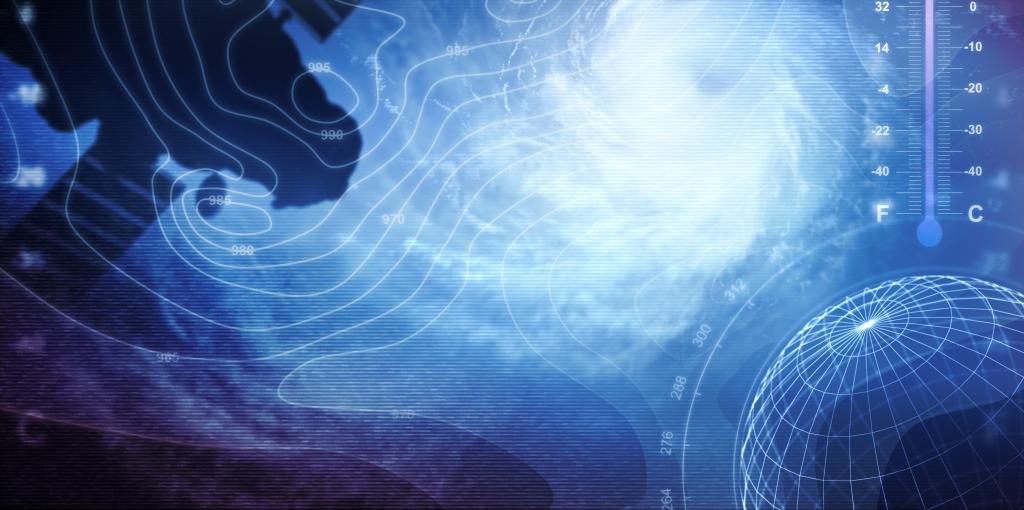Aerosols, Air Quality, Mesoscale Dynamics, and Remote Sensing
- Home
- Academics
- Departments & Units
- Atmospheric, Oceanic & Earth Sciences
- Research
- Aerosols, Air Quality, Mesoscale Dynamics, and Remote Sensing
Admission CTAs
Main navigation
Section Navigation: Research
Aerosols, Air Quality, Mesoscale Dynamics, and Remote Sensing
Air pollution is a burden imposed on human society by industrialization. Exposures to air pollution caused 8 million premature deaths per annum, making it the single largest environmental risk today (WHO). In the United States, over one third of the population lives in areas not attaining the health-based National Ambient Air Quality Standards (NAAQS) for ozone (O3) and fine particulate matter (PM2.5) (EPA). AOES faculty have broad interests in the major disciplines of aerosols, air quality, mesoscale dynamics, and remote sensing.
Aerosol Effects
There is considerable evidence that the concentration of aerosols in the troposphere has increased over the last 150 years due to human activity and may increase further as developing countries grow in population and industry. In order to achieve a complete understanding of past and future climate change, a thorough assessment of aerosol-cloud-radiation interactions (i.e., direct, indirect, and semi-direct aerosol effects) is required. For example, the Arctic is a key area of global climate change, with warming rates at almost twice the global average rate and the fast retreat of Arctic sea-ice. This dramatic change in the Arctic climate system strongly affects global weather and climate. Many processes in the Arctic climate system are extremely complex due to the strong seasonal cycles (darkness and sunlight periods), surface characteristics (sea-ice, glacial ice and snow types) and Arctic clouds (controlling the snow/ice albedo).
AOES faculty Boybeyi, and his students, have been investigating the effects of aerosols on Arctic surface temperature using WRF-CHEM model simulations (Stofferahn and Boybeyi, 2017a, b; Lindeman et al., 2011). While much has been speculated about the cooling role of indirect aerosol effects, these studies indicate that indirect aerosol effects can have a strong warming effect at night over sea-ice. This strong night-time surface temperature warming is the result of a high fine mode aerosol concentration, which leads to an increase in cloud optical depth and a strong increase in downward longwave radiation. This research indicates that aerosol-cloud-radiation interactions are yet another piece of the puzzle in advancing our understanding of the Arctic climate system and the ongoing sea-ice loss. More importantly, the role of aerosol indirect effects (specifically the warming effect) during the long Arctic darkness period over sea-ice remains an important research question.
Surface temperature change due to aerosol indirect effects on April 19-20, 2008 (cf., Stofferahn & Boybeyi, 2017a, b). Note that the increase in surface temperature up to about 3-4 0C (warming) is occurring over sea-ice region (top panels).
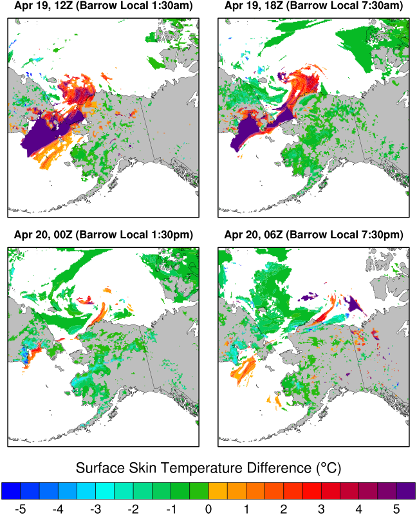
Emission Modeling and Air Surface Exchange
Emissions are the beginning of many environmental problems, from air pollution, regional haze, acid rain, to climate change. Consequently, solutions to these problems reside in better understanding emission sources and their impacts on the environment. Scientists at GMU are recognized experts in emission modeling and using in-situ/satellite observations to reduce emission uncertainties. Research in this area includes development of process-based emission models, emission forecasting, satellite observations of trace gas and aerosol emissions, and emission data assimilation.
Air Quality Forecasting and Prediction
Air quality forecasting is one of the key tools commonly used by state and local agencies to protect the public from the adverse health effects of poor air quality. Air quality and public health managers have an important task to protect public health by alerting the population when forecasts predict the exceedance of the NAAQS. During exceedance, action days are issued and, depending on the levels of severity, specific sensitive groups or the entire population are advised to reduce outdoor activities or take other protective measures. Accurate prediction of the timing, location, and severity of unhealthy air quality episodes is critical for decision-makers to protect human health. GMU operates a research forecasting system for ozone (O3), fine particulate matter (PM2.5), wildfires, and dust storms. Our scientists also contribute to the development of the National Air Quality Forecast Capability (NAQFC) operated by the National Weather Service.
Extreme Air Quality Events (Dust Storms, Wildfires and Volcanic Eruption)
Extreme Air Quality Events (Dust Storms, Wildfires and Volcanic Eruption)
Although air quality continues to improve in the United States, the frequency of high-impact extreme events, such as wildfires and dust storms, has increased rapidly in the past decades and is projected to rise further in response to climate change. Hazardous events can impose drastic impacts on society, including adverse health effects, life and property losses.
Observations and Predictability of Dust Storms
GMU has developed a simple but powerful indicator to document the

Dust storms in the western United States has increased 240% from 1990s to 2011 (Fig. 1), at a rate 10-fold faster and in the opposite direction of the global dust trend (Tong et al., GRL, 2017).
Rising dust activity imposes myriad effects on the environment and society, including poor air quality, infectious diseases, highway and aviation safety, cropland erosion, and reduced solar energy productivity. Unlike traditional emission sources, dust storms are difficult to predict. GMU scientists and students are developing and improving a state-of-the-art dust emission model, called FEGNSHA (windblown dust in Mandarin), that has been used air quality research and operational dust forecasting.
Forecasts of two dust storms (in red color with high PM10 concentrations) during the 2018 Tax Day (April 17, 2018) (Tong and Tang, 2019). Over north America there is an interesting phenomenon, called “Tax Day dust storm”. Each year, on the day when Americans file their tax returns, one or more large dust storms often sweep over the southwest. Figure 2 shows the forecast of the “Tax Day” dust storms in 2018.
Wildfires
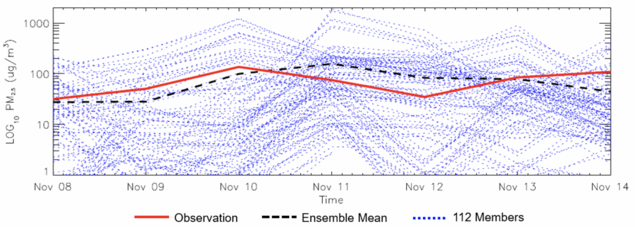
In collaborations with several federal agencies (NASA, NOAA, and NRL), GMU is working on assessing and improving satellite fire emission products, such as NOAA GBBEPx, NASA FEER and NRL FLAMBE. Satellite observations of aerosols and trace gases are used to improve these products through inverse emission modeling. Other factors, such as meteorology and plume rise algorithms, also play important roles in shaping fire and smoke plumes. Our team has built a North America wildfire ensemble forecasting system to predict air quality during wildfire events.
Volcanic eruptions
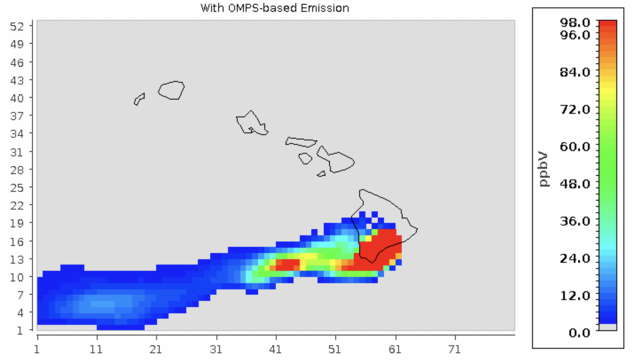
At times of natural disasters such as volcanic eruptions, elevated levels of toxic gases and particles can result in severe health stress among the people living in the impacted areas, and further downwind. Advanced air quality forecasting systems can be equipped with near real-time emission estimates to provide critical air quality data to assess population exposure to volcanic smog (vog) and to assist in developing effective evacuation plans, if necessary. Near real-time estimates of volcanic emissions can be made from SO2 and aerosol vertical column density by satellite sensors, such as OMI and Ozone Mapping Profiling Suite (OMPS). The health-based air quality standard for sulfur dioxide (SO2) is 75ppbv, which has been frequently exceeded in the areas downwind to the Kilauea volcano during the eruption on May 17, 2018.
Atmospheric Transport & Dispersion (AT&D)
In recent decades, complex AT&D models (such as Hazard Prediction and Assessment Capability, HPAC) for the simulation of atmospheric hazard release of chemical, biological, radiological, and nuclear (CBRN) agents are used pervasively in scientific research, and there are increasing demands for these models to support policy- and decision-making. As decision and policy makers come to rely increasingly on estimates and simulations produced by these models, the need for uncertainty quantification, interpretation, and communication of such models becomes more urgent.
Therefore, there is a need for a standardized set of field and laboratory datasets to be used for AT&D model development and evaluation. Over the past two decades, AOES faculty Boybeyi and collaborators have been collecting, archiving, and quality assuring both field (local-scale to mesoscale) and laboratory scale atmospheric transport and dispersion datasets to be used in model development, evaluation and uncertainty analysis studies (e.g., Boybeyi et al., 2001; Chang et al., 2005). The list of the archived datasets inventory (total 36 field and laboratoryexperiment datasets) can be found at -http://camp.cos.gmu.edu/data_resources_overview.html.
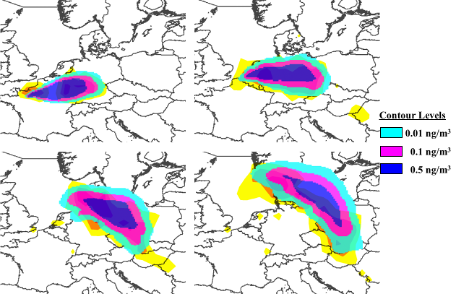
Regional scale hazard prediction (Boybeyi et al., 2000). OMEGA model evaluation against European Tracer Experiment (ETEX) measurements. Model simulations results superimposed on the field measurements (24, 36, 48 and 60 hours).
In addition, Boybeyi has been organizing and hosting an annual conference on George Mason University (GMU) Atmospheric Transport and Dispersion (AT&D) Modeling for over twenty years. Each year, approximately 50 technical papers are presented and archived by the GMU (http://camp.cos.gmu.edu/24th-announcement.html) with about 100-150 national and international participants. This collection of conference papers, presentations, and technical documentation is unique in the field of AT&D for its broad spectrum of topics and presenters. The technical topics covered a wide range under the general category of atmospheric transport and dispersion modeling from urban scale to regional scale. Major topic areas include sensor data fusion, urban-scale meteorological and dispersion experiments and models (Bakosi et al., 2010), mesoscale meteorological modeling (Boybeyi et al., 2007), new developments in basic theories of transport and dispersion models uncertainty/sensitivity analyses (Bakosi et al., 2007 & 2008), risk assessments, and methods and criteria for emergency response and decision-making. The main goal of the conference was to provide a forum for exchange of ideas on ongoing research in the above major topic areas.
Selected References
Stofferahn, E. & Boybeyi, Z. (2017a): Investigation of aerosol effects on the Arctic surface temperature during the diurnal cycle: part 1 – total aerosol effect. Int. J. Climatol, 37: 761–774.
Stofferahn, E. & Boybeyi, Z. (2017b): Investigation of aerosol effects on the Arctic surface temperature during the diurnal cycle: part 2 – Separating aerosol effects. Int. J. Climatol, 37: 775–787.
Lindeman, J. & Z. Boybeyi & I. Gultepe (2011): The aerosol semidirect effect during a polluted case of the ISDAC field campaign. Journal of Geophysical Research, Vol. 116, D00T10,doi:10.1029/2011JD015649.
Bakosi, J., P. Franzese & Z. Boybeyi (2010): Joint PDF Modeling of Turbulent Flow and Dispersion in an Urban Street Canyon. Boundary Layer Meteorology, DOI 10.1007/s10546-009-9370-x.
Bakosi, J., P. Franzese & Z. Boybeyi (2008): A non-hybrid method for the PDF equations of turbulent flows on unstructured grids. J. Comput. Phys., 227, 5896-5935.
Bakosi, J., P. Franzese & Z. Boybeyi (2007): Probability density function modeling of scalar mixing from concentrated sources in turbulent channel flow. Physics of Fluids, 19, 1-17 (DOI: 10.1063/1.2803348).
Boybeyi Z., E. Novakovskaia, D. P. Bacon, M. Kaplan & R. MacCracken (2007): Targeted GOES Satellite Observations to Improve Hurricane Track Forecast. Pure and applied geophysics, 164, 2083-2100.
Chang J., S. R. Hanna, Z. Boybeyi & P. Franzese (2005): Use of Salt Lake City Urban 2000 Field Data to Evaluate the Urban Hazard Prediction Assessment Capability (HPAC) DispersionModel. Journal of Applied Meteorology, 44, 485-501.
Boybeyi Z., N. N. Ahmad, D. P. Bacon, T. J. Dunn, M. S. Hall, P. C. S. Lee, R. A. Sarma & T. R. Wait (2001): Evaluation of the Operational Multi-scale Environment model with GridAdaptivity against the European Tracer Experiment. Journal of Applied Meteorology, 40, 1541-1558.
Student Opportunities
Student opportunities described below; contact the indicated faculty for details.
Undergraduate Research Opportunities
Undergraduates may work with faculty on the above research projects, or on projects developed independently by the student, supported by OSCAR or as independent research credits.
Graduate Research Opportunities
Graduates may work with faculty on the research projects, or independently with support from a GRA (when available), a College of Science GTA, or a successful fellowship.
